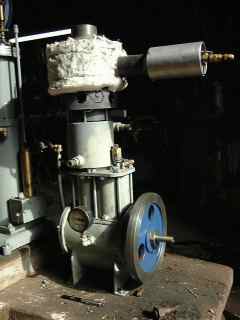

How Stirlings Work
A stirling is one of the least complex of all modern engines. It contains no valves, cams or carburetors. It is simply an enclosed vessel containing air or another gas that is alternately heated and cooled. A piston then extracts this energy being alternately pushed and pulled by the expanding and contracting gas.
Stirlings are usually classified into three categories:
An Alpha Stirling has two cylinders each containing a piston. One cylinder is kept hot while the other is cooled. A Displacer Piston attached to the end of each power piston continuously pushes the air back and forth between the hot and cold cylinders. The regenerator is located in the passage between the two cylinders.
A Beta Stirling is arranged in a long tube with the power piston at one end. Air is continuously pushed from a heated section of the tube to a cooled area by a displacer piston. The regenerator is located between the hot and cold areas of the tube.
A Gamma Stirling is similar to a Beta except the power piston is located in its own cylinder. The two cylinders are connected by a short passage. The regenerator is located between the hot and cold ends of the main vessel. Gamma engines are usually less efficient and powerful than a similar beta but they are much simpler mechanically. In all stirlings the two pistons are out of phase by 90.
Stirlings that operate with a gas at atmospheric pressure do not produce much power because the density of the gas is low. If a compact powerful engine is needed the working gas must be pressurized inside the engine. This necessitates that the engine be well sealed and strong. Some stirlings, such as ones for vehicles, are pressurized at up to 3000 psi.
Another problem with stirlings is that they are inefficient and slow if air is used as the working gas. If a lighter gas is used, such as hydrogen or helium, the engine's power increases and the efficiency soars. Some stirling engines can attain an efficiency of over 30%.
In order to run a stirling you only need a difference in temperature. Some stirlings can even run on the difference between your hand and the air. Stirlings are also very quiet. This makes stirlings ideal for Solar and geothermal power. Stirlings may also run on biomass, wood or nuclear power with no problems.
![]() Learn the History of the Stirling Cycle Engine
Learn the History of the Stirling Cycle Engine
Learn More?
![]() Visit this site in Japan by Koichi Hirata.
Visit this site in Japan by Koichi Hirata.
You May Reach Me At
![]() dustin@starspin.com
dustin@starspin.com